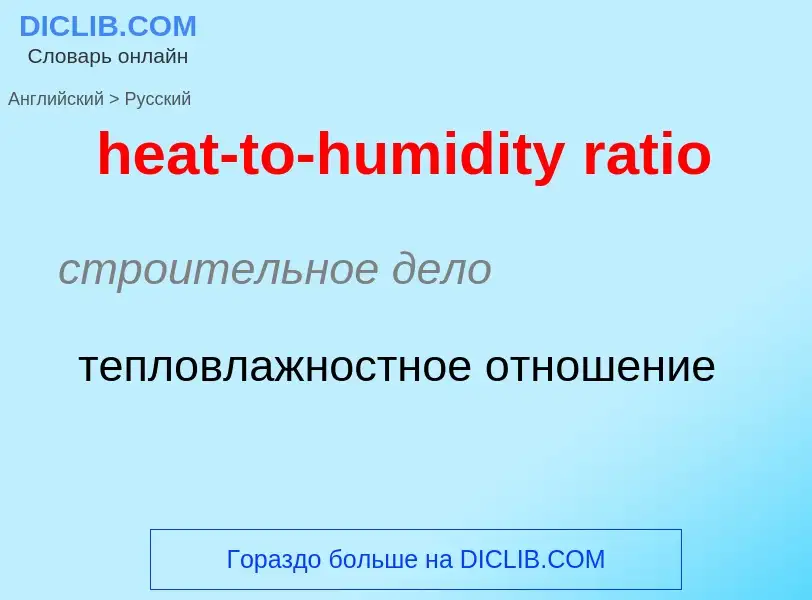Перевод и анализ слов искусственным интеллектом ChatGPT
На этой странице Вы можете получить подробный анализ слова или словосочетания, произведенный с помощью лучшей на сегодняшний день технологии искусственного интеллекта:
- как употребляется слово
- частота употребления
- используется оно чаще в устной или письменной речи
- варианты перевода слова
- примеры употребления (несколько фраз с переводом)
- этимология
heat-to-humidity ratio - перевод на русский
строительное дело
тепловлажностное отношение
общая лексика
показатель адиабаты
строительное дело
показатель адиабаты
общая лексика
D/E ratio соотношение заемных и собственных средств
(отношение суммы краткосрочных обязательств и долгосрочных заимствований к собственному капиталу; чем выше этот коэффициент, тем меньше защита кредиторов и больше финансовый риск)
синоним
Определение
Википедия

Humidity is the concentration of water vapor present in the air. Water vapor, the gaseous state of water, is generally invisible to the human eye. Humidity indicates the likelihood for precipitation, dew, or fog to be present.
Humidity depends on the temperature and pressure of the system of interest. The same amount of water vapor results in higher relative humidity in cool air than warm air. A related parameter is the dew point. The amount of water vapor needed to achieve saturation increases as the temperature increases. As the temperature of a parcel of air decreases it will eventually reach the saturation point without adding or losing water mass. The amount of water vapor contained within a parcel of air can vary significantly. For example, a parcel of air near saturation may contain 28 g of water per cubic metre of air at 30 °C (86 °F), but only 8 g of water per cubic metre of air at 8 °C (46 °F).
Three primary measurements of humidity are widely employed: absolute, relative, and specific. Absolute humidity is expressed as either mass of water vapor per volume of moist air (in grams per cubic meter) or as mass of water vapor per mass of dry air (usually in grams per kilogram). Relative humidity, often expressed as a percentage, indicates a present state of absolute humidity relative to a maximum humidity given the same temperature. Specific humidity is the ratio of water vapor mass to total moist air parcel mass.
Humidity plays an important role for surface life. For animal life dependent on perspiration (sweating) to regulate internal body temperature, high humidity impairs heat exchange efficiency by reducing the rate of moisture evaporation from skin surfaces. This effect can be calculated using a heat index table, also known as a humidex.
The notion of air "holding" water vapor or being "saturated" by it is often mentioned in connection with the concept of relative humidity. This, however, is misleading—the amount of water vapor that enters (or can enter) a given space at a given temperature is almost independent of the amount of air (nitrogen, oxygen, etc.) that is present. Indeed, a vacuum has approximately the same equilibrium capacity to hold water vapor as the same volume filled with air; both are given by the equilibrium vapor pressure of water at the given temperature. There is a very small difference described under "Enhancement factor" below, which can be neglected in many calculations unless great accuracy is required.






![[[Humidor]], used to control humidity of cigars [[Humidor]], used to control humidity of cigars](https://commons.wikimedia.org/wiki/Special:FilePath/Humidor innen.jpg?width=200)

![primary efflorescence]]) primary efflorescence]])](https://commons.wikimedia.org/wiki/Special:FilePath/Primary efflorescence decades later 001.png?width=200)


![[[Desiccant]] bag ([[silica gel]]), commonly included in packages containing electronic products to control humidity [[Desiccant]] bag ([[silica gel]]), commonly included in packages containing electronic products to control humidity](https://commons.wikimedia.org/wiki/Special:FilePath/Silica gel - bag.jpg?width=200)
![''[[Tillandsia usneoides]]'' in Tropical house, Royal Botanic Gardens, Kew. It is growing where the climate is warm enough and has a relatively high average humidity. ''[[Tillandsia usneoides]]'' in Tropical house, Royal Botanic Gardens, Kew. It is growing where the climate is warm enough and has a relatively high average humidity.](https://commons.wikimedia.org/wiki/Special:FilePath/Tillandsia usneoides (14956541092).jpg?width=200)
![A [[hygrothermograph]] for humidity and temperature recording A [[hygrothermograph]] for humidity and temperature recording](https://commons.wikimedia.org/wiki/Special:FilePath/Umidaderelativa.jpg?width=200)





